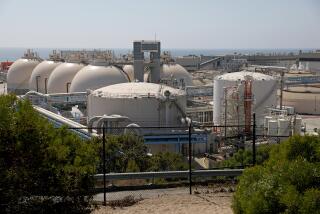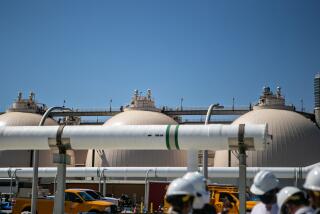EPA, Navy Agree on Plan to End Waste Violations : Port Hueneme: The deal will resolve 12 violations discovered last year at the base. It does not affect past chemical dumping.
- Share via
The U.S. Environmental Protection Agency and the Navy have agreed on how to resolve 12 hazardous waste violations discovered last year at the Naval Construction Battalion Center in Port Hueneme.
The violations involve improper labeling of hazardous waste containers, record-keeping flaws, poor personnel training and the storage of hazardous waste containers beyond a 90-day federal limit, EPA officials said. The EPA cited the Navy for the violations on Sept. 28.
The hazardous waste includes solvents, paint thinner and acids, a Navy spokeswoman said.
In addition, the Navy base was cited for having an inadequate waste analysis plan, which is supposed to identify hazardous waste on the base and detail ways to dispose of it.
The EPA-Navy agreement reached Wednesday establishes a schedule for the Navy to meet EPA guidelines on hazardous waste storage, officials said. In addition, the Navy was given 60 days to develop a plan to reduce the volume and toxicity of hazardous wastes generated on the base, officials said.
“The U.S. Navy has been very responsive and diligent in working toward a resolution of current hazardous waste violations,” said Jeff Zelikson, director of hazardous waste management for the EPA’s regional office in San Francisco.
EPA officials said the agreement does not address the dumping of other hazardous waste, such as PCPs, sulfuric acid and radioactive crushed rock, which were uncovered on the base in a 1985 military study.
An EPA spokesman in San Francisco said the federal agency inspected the Navy base last year to address the Navy’s storage of hazardous waste and not to investigate past dumpings.
A 1985 study by soil analysts hired by the Navy uncovered numerous toxic waste dumps on the naval base. About 11,300 people live on base.
The study, portions of which were disclosed by lawyers in a complex multibillion-dollar lawsuit involving oil waste buried beneath an Oxnard subdivision, says that PCBs, formaldehyde and battery acid are buried within the 1,615-acre base.
Also dumped on the base were thousands of gallons of hydraulic fluid, 40,000 gallons of sulfuric acid, 10,000 gallons of thinner and solvent and 11,800 cubic yards of crushed radioactive rock, according to the study.
However, officials at the base have said the dumped chemicals do not pose a health threat to base workers.
Navy spokeswoman Linda Wadley said Navy officials are studying the waste dumps to determine what must be cleaned up and how that should be done.
In addition, Wadley said naval officials have increased from four to 11 the number of workers assigned to store and dispose of hazardous waste at the base.
“We are certainly trying to improve the program,” she said.
More to Read
Sign up for Essential California
The most important California stories and recommendations in your inbox every morning.
You may occasionally receive promotional content from the Los Angeles Times.













